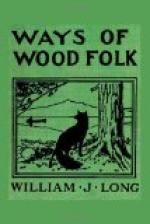Twice since then I have seen them do the same thing. I have no doubt they returned that evening all the way up to the feeding grounds where we first started them; for like the kingfishers every bird seems to have his own piece of the stream. He never fishes in his neighbor’s pools, nor will he suffer any poaching in his own. On the Restigouche we found a brood every few miles; on other rivers less plentifully stocked with trout they are less numerous. On lakes there is often a brood at either end; but though I have watched them carefully, I have never seen them cross to each other’s fishing grounds.
Once, up on the Big Toledi, I saw a curious bit of their education. I was paddling across the lake one day, when I saw a shellbird lead her brood into a little bay where I knew the water was shallow; and immediately they began dipping, though very awkwardly. They were evidently taking their first lessons in diving. The next afternoon I was near the same place. I had done fishing—or rather, frogging—and had pushed the canoe into some tall grass out of sight, and was sitting there just doing nothing.
A musquash came by, and rubbed his nose against the canoe, and nibbled a lily root before he noticed me. A shoal of minnows were playing among the grasses near by. A dragon-fly stood on his head against a reed—a most difficult feat, I should think. He was trying some contortion that I couldn’t make out, when a deer stepped down the bank and never saw me. Doing nothing pays one under such circumstances, if only by the glimpses it gives of animal life. It is so rare to see a wild thing unconscious.
Then Kwaseekho came into the shallow bay again with her brood, and immediately they began dipping as before. I wondered how the mother made them dive, till I looked through the field-glass and saw that the little fellows occasionally brought up something to eat. But there certainly were no fish to be caught in that warm, shallow water. An idea struck me, and I pushed the canoe out of the grass, sending the brood across the lake in wild confusion. There on the black bottom were a dozen young trout, all freshly caught, and all with the air-bladder punctured by the mother bird’s sharp bill. She had provided their dinner, but she brought it to a good place and made them dive to get it.
As I paddled back to camp, I thought of the way the Indians taught their boys to shoot. They hung their dinner from the trees, out of reach, and made them cut the cord that held it, with an arrow. Did the Indians originate this, I wonder, in their direct way of looking at things, almost as simple as the birds’? Or was the idea whispered to some Indian hunter long ago, as he watched Merganser teach her young to dive?




